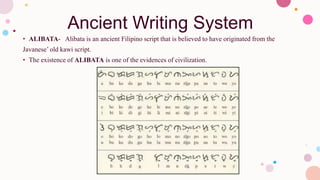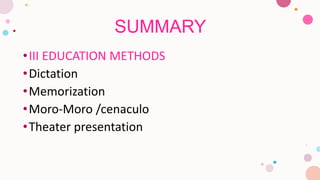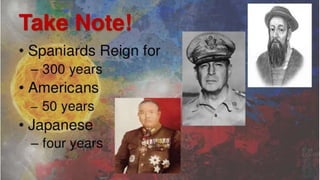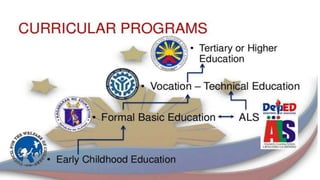623684691-Organization-and-Structure-of-the-Philippine-Education-System.pptx
- 1. ORGANIZATION AND STRUCTURE OF THE PHILIPPINE EDUCATION SYSTEM Prepared by: JAN ANDREA P. REYES
- 2. Philippine Education Then and Now Pre- Spanish Time Spanish Regime American Regime Japanese Regime Philippine Education under New Society Philippine Education under the Present System
- 5. Content of Education Broad, indefinite and unwritten; Unstructured; Research later shows Filipinos already have their own “baybayin” alphabet because of ALIBATA
- 6. Ancient Writing System • ALIBATA- Alibata is an ancient Filipino script that is believed to have originated from the Javanese’ old kawi script. • The existence of ALIBATA is one of the evidences of civilization.
- 8. EDUCATIONAL SYSTEM/CURRICULUM Formal and Organized Religion oriented Education Spanish missionaries as tutors Spanish language-cumpolsary Teach and catechism to the natives Christian doctrine, prayers, and sacred songs
- 9. EDUCATIONAL SYSTEM/CURRICULUM •3R’s were only given to brighter pupils •Inadequate education READ WRITE ARITHMETIC (suppressed/limited/controlled) •Education is a privilege not a right •Education for the Elite •Controlled by friars
- 10. Major Problems • Lack of trained teachers • Lack of teachers (150 teacher missionaries to instruct over half a million inhabitants) • Lack of funds, instructional materials, and in many instances school houses
- 11. Structure Church Parish Priest Prayle/ Friars Students Elite Family
- 12. January 1, 1863: Educational Decree of 1862 • Access to education by the Filipinos was later liberalized through the enactment of the Educational decree of 1863. • Provided for the establishment of at least one primary school for boys and girls in each town under the responsibility of the municipal government; • Establishment of a normal school for male teachers under the supervision of the Jesuits • The Spanish schools started accepting Filipino students. • Intellectual Filipino emerged
- 13. Subject: Based on Royal Decree 1863 •Languages(Latin, Spanish grammar and literature, elementary Greek, French and English) •History ( Universal, Spanish) •Mathematics (Arithmetic, Algebra, Trigonometry, Geometry) •Philosophy (Rhetoric, Logic, Ethics) •Geography •Psychology
- 14. Philippine Revolution • I. Illustrados spearheaded the propaganda Movement • II. Curricular reforms • 1. Secularization of Education • 2. Instruction of Spanish • 3.Greater attention to natural science • 4.The design of a relevant curriculum • 5. Improvement of higher centers of learning • 6.Improvementof educational system
- 15. Philippine Revolution • III. Jose Rizal criticized unequivocally the friars’ method of instruction in his two novels Noli Me tengere and El filibusterismo • 1. Disproportionate focus on religion. • 2. Discourage the attempt of Filipino students to speak in Spanish • 3. Lack of pedagogical skills • Irrelevant courses in the curriculum
- 16. Curriculum • To improved the existing curriculum, Rizal considered the ff. subjects as required courses in secondary school. Science Math History Philosophy Law Language P.E Religion Music Social Sciences
- 17. January 1, 1565 Parochial Schools •Rise of parochial schools started by the Agustinians and later by other religious Spanish orders. Among the 1st school are: •Colegio De San Ignacio (1589) •Beaterio de Sta. Potenciana ( 1st only-girls school in 1594) •UST (1611)
- 18. UST was the only institution of higher learning offering courses such as medicine, pharmacy, midwifery and law.
- 19. SUMMARY • I. Educational Aims II Educational Types • To promote Christianity Formal Education •Promotion of Spanish Language Religious Education •Promotion of Spanish Language Doctrine •Imposition of Spanish value Vocational course
- 20. SUMMARY •III EDUCATION METHODS •Dictation •Memorization •Moro-Moro /cenaculo •Theater presentation
- 21. FIRST REPUBLIC •(1898-1901) 1899 Malolos Constitution- Article XIV First Republic •1898-1901
- 22. First Republic Education was; •Education •Priority during the Malolos Republic •August 29, 1898-school were re-opened by The secretary of the interior General Aguinaldo( seated, center) and ten of the delegates to the first assembly that passed the constitution, in the Barasoain Church, Malolos (Taken December 8, 1929)
- 24. EDUCATIONAL AIM: Love for country and of God
- 25. Educational Highlights • Curricular reforms • Secularization of Education • Greater Attention to natural science • The design of a relevant curriculum • The Improvement of higher centers of learning • Improvement of Educational system • Disproportionate focus on religion • Discourage the attempt of Filipino students to speak in Spanish • Lack of pedagogical skills • Irrelevant courses in the curriculum
- 27. Educational Aims •Training Filipino in; •Democratic way of life •Citizenship •Moral Character •Vocation Education
- 28. Glimpse from the Past •American Expeditionary forces were sent to the Philippines with a mission to destroy Spanish Armada in Manila Bay as part of the strategy to defeat the Spaniards in the Spanish American War ranging at that time in Cuba.
- 29. Spanish Armada
- 30. Glimpse from the Past •The Americans won, and on the Treaty of Paris on December 10, 1898, the Philippines was ceded to the United State by the Spanish for the paltry sum of US $20 million
- 31. Educational System 1898 •American Occupied Manila •RE-opened schools were in the American soldiers were the first teacher
- 32. Educational System •Thomasites heralding the institution of English as the new medium of instruction. •Public schools system was instituted making it obligatory for all children, •Education was given for free. •English and mathematics dominated the curriculum and the teaching of religion was prohibited.
- 33. The American Revised Curriculum •The curriculum was based on the ideals and traditions of American and her hierarchy of values. •The primary curriculum prescribed in 1904 by the Americans for the Filipinos consisted of three Grades which provides training in two aspects:
- 59. THANK YOU!!!!


























































